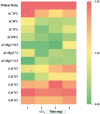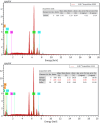Assessment of the performance of Ni carbon nanotube nano composite coatings and activated carbon for diesel exhaust treatment
- PMID: 39915655
- PMCID: PMC11802834
- DOI: 10.1038/s41598-025-88823-6
Assessment of the performance of Ni carbon nanotube nano composite coatings and activated carbon for diesel exhaust treatment
Abstract
Diesel engines are essential in sectors such as transportation, agriculture, and power generation, offering benefits like fuel efficiency, high power output, and durability. However, their emissions (NOX, CO2, CO, HC, SO2, and PM) significantly contribute to air pollution, posing serious environmental and health risks. This study aimed to design and fabricate a unit that simulates diesel engine emissions and tests various purification materials. The unit consists of a combustion chamber, filtration media, and exhaust pipes, with materials such as activated carbon, activated carbon with magnesium oxide, and Ni-Carbon Nanotube (CNTs) nanocomposites tested under controlled combustion conditions to measure their pollutant removal efficiencies. Results showed that 100% activated carbon achieved pollutant removal efficiencies of 85.21% for CO2, 80.77% for CO, and 68.84% for HC. Combining activated carbon with magnesium oxide (AC: MgO) enhanced these efficiencies to 76.92% for CO2, 86.84% for CO, and 73.28% for HC. Ni-CNTs nanocomposites (at 0.2 concentration) demonstrated the highest performance, with removal efficiencies of 93.13% for CO2, 94.87% for CO, and 76.02% for HC. These results emphasize the potential of Ni-CNTs nanocomposites as highly efficient materials for reducing diesel exhaust emissions, contributing significantly to cleaner air, better public health, and more sustainable diesel technologies.
Keywords: Diesel Engine; Diesel treatment device; Emission Control; Emission control technologies; Material Treatment.
© 2025. The Author(s).
Conflict of interest statement
Declarations. Competing interests: The authors declare no competing interests. Ethical approval: No experimental in human tissue.
Figures















References
-
- Afifa; Arshad, K., Hussain, N., Ashraf, M. H. & Saleem, M. Z. Air pollution and climate change as grand challenges to sustainability. Sci. Total Environ.928, 172370 (2024). - PubMed
-
- Lamb, W. F. et al. A review of trends and drivers of greenhouse gas emissions by sector from 1990 to 2018. Environ. Res. Lett.16, 73005 (2021).
-
- Vijay Kumar, M. et al. Investigation of the combustion of exhaust gas recirculation in diesel engines with a particulate filter and selective catalytic reactor technologies for environmental gas reduction. Case Stud. Therm. Eng.40, 102557 (2022).
-
- Sharma, N., Mitra, K., Pezer, J., Pathak, R. & Sjöblom, J. Characterization from Diesel and Renewable Fuel Engine Exhaust: Particulate Size/Mass Distributions and Optical Properties. Aerosol Science and Engineering 25, e 0123456789. (2023).
LinkOut - more resources
Full Text Sources

